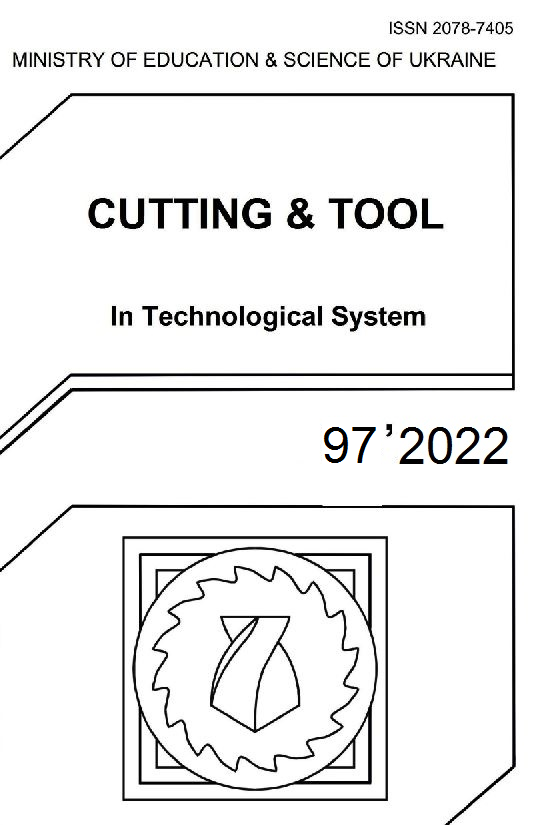THE EFFECT OF BURNISHING PROCESS ON SKEWNESS AND KURTOSIS OF THE SCALE LIMITED SURFACE
DOI:
https://doi.org/10.20998/2078-7405.2022.97.07Keywords:
low-alloy aluminum, smoothing, surface roughness, parameters of the 3D topography of the surfaceAbstract
In this paper roughness examination and analysis on burnished low alloyed aluminium surfaces are reported, highlighting 2 parameters from the vertical deviations of the roughness profile from the mean line. From the input parameters of the burnishing process, the effect of burnishing force, feed rate, speed and number of passes are investigated. Measurements of the surface topography – before and after burnishing – are conducted on an Altisurf 520 3D measuring device. The generated and calculated values of the machined surface roughness are analysed in detail with the drawing of the conclusions as well.
References
J. Kundrák, A. Nagy, A.P. Markopoulos, N.E. Karkalos: Investigation of surface roughness on face milled parts with round insert in planes parallel to the feed at various cutting speeds, Rezanie I Instrumenty V Tekhnologicheskih Sistemah 91, (2019) 87-96.
G. N. Tóth, Á. Drégelyi-Kiss, B. Palásti-Kovács: Analysis of the microgeometric parameters of cut surfaces, Pollack Periodica: an international journal for engineering and information sciences vol. 8 (2013). 55-66.
Á. Drégelyi-Kiss, Á. Czifra, B. Palásti-Kovács: Comparison of capability calculations of surface roughness measurement in automotive industry, Proceedings of the ISMQC (2013) 1-8.
V. Molnár, I. Sztankovics: Analysis of Roughness Parameters Determining Tribological Properties in Hard Turned Surfaces, Hungarian Journal Of Industry And Chemistry 49:2 (2021) 77-84.
EN ISO 4287 Geometrical Product Specification (GPS) - Surface texture: Profile method. Terms, definitions and surface texture parameters (1997)
ISO/DIS 25178-2: Geometrical product specification (GPS) - Surface texture: Areal - Part 2. Terms, definitions and surface texture parameters (2012).
G. Farkas: Esztergált műszaki műanyag felületek mikrotopográfiai jellemzői, Ph.D. értekezés, (2010) 1-138.
J. Kundrák, I. Sztankovics, V. Molnár: Accuracy and topography analysis of hard machined surfaces, Manufacturing Technology 21:4, (2021) 512-519.
S. Dzionk, B. Scibiorski, W. Przybylski: Surface texture analysis of hardened shafts after ceramic ball burnishing, Materials vol. 204, (2019) 1-15.
A. Skoczylas, K. Zaleski: Selected properties of the surface layer of C45 steel parts subjected to laser cutting and ball burnishing, Materials 3429, (2020) 1-19.
H. Luo, J. Liu, L. Wang, Q. Zhong: Investigation of the burnishing process with PCD tool on non-ferrous metals, Int. J. Adv. Manuf. Technol. 25, (2005) 454-459.
G. Varga, B. Sovilj, I. Pasztor: Experimental Analysis of Sliding Burnishing, Academic Journal of Manufacturing Engineering 11, (2013) 6-11.
MR. Stalin John, P. Suresh, D. Raguramand, BK. Vinayagam: Surface characteristics of low plasticity burnishing for different materials using lathe, Arab J Sci Eng. 39, (2014) 3209–3216.
A. Akkurt: Comparison of roller burnishing and other methods of finishing treatment of the surface of openings in parts from tool steel D3 for cold forming, Metal Science and Heat Treatment 53, (2011)145-150.
L. Luca, S. Neagu-Ventzel, I. Marinescu: Effects of working parameters on surface finish in ball-burnishing of hardened steels, Precision Engineering 29, (2005) 253-256.
W. Grzeski, B. Kruszynski, A. Ruszaj: Surface integrity of machined surfaces, Materials Science (2010) 143-179.
C. Cao, J. Zhu, T. Tanaka, D.N. Pham: Invetsigation of corrosion resistance enhancemet for biodegradable magnesium alloy by ball burnishing process, Int. J. of Automation Technology 14, (2020) 175-183.
R. Horváth, Á. Drégely-Kiss, Gy. Mátyási: The examination of surface roughness parameters in the fine turning of hypereutectic aluminium alloys, U. P. B. Sci. Bull., Series D 77, (2015) 205-216.
Varga, G.: Effects of technological parameters on the surface texture of burnished surfaces, Key Engineering Materials 581, (2014), 403-408.
D. Toboła, P. Rusek, K. Czechowski, T. Miller, K. Duda: New Indicators of Burnished Surface Evaluation – Reasons of Application, Metrol Meas Syst 12, (2015), 263–274.
G. Farkas, K. B Palásti, G. Kalácska: Műszaki felületek mikrogeometriai vizsgálata, MTA Agrárműszaki Bizottság, XXIX. Kutatási és Fejlesztési Tanácskozás, (2005), 113-117.
R. Deltombe, M. Kubiakk, R. Krzysztof, M. Bigerelle: How to select the most relevant 3D roughness parameters of a surface, Scanning 36, (2014), 150-160. 23. ISO 22081:2021, Geometrical product specifications (GPS) – Geometrical tolerancing – General geometrical specifications and general size specifications, (2021), https://www.iso.org/standard/72514.html (Viewed: 01/06/22).
T.A. El-Taweel, M.H. El-Axir: Analysis and optimization of the ball burnishing process through the Taguchi technique, International Journal of Advanced Manufacturing Technologies 41, (2009), 301-310.
K. B. Palásti: Gépalkatrészek minősége. Tervezés, gyártás, minősítés. BMF BGK, Főiskolai jegyzet (2001) 10-25.
Downloads
Published
Issue
Section
License
Copyright Notice
Authors who publish with this Collection agree to the following terms:
1. Authors retain copyright and grant the Collection right of first publication with the work simultaneously licensed under a Creative Commons Attribution License that allows others to share the work with an acknowledgement of the work's authorship and initial publication in this Collection.
2. Authors are able to enter into separate, additional contractual arrangements for the non-exclusive distribution of the Collection's published version of the work (e.g., post it to an institutional repository or publish it in a book), with an acknowledgement of its initial publication in this Collection.
3. Authors are permitted and encouraged to post their work online (e.g., in institutional repositories or on their website) prior to and during the submission process, as it can lead to productive exchanges, as well as earlier and greater citation of published work.

